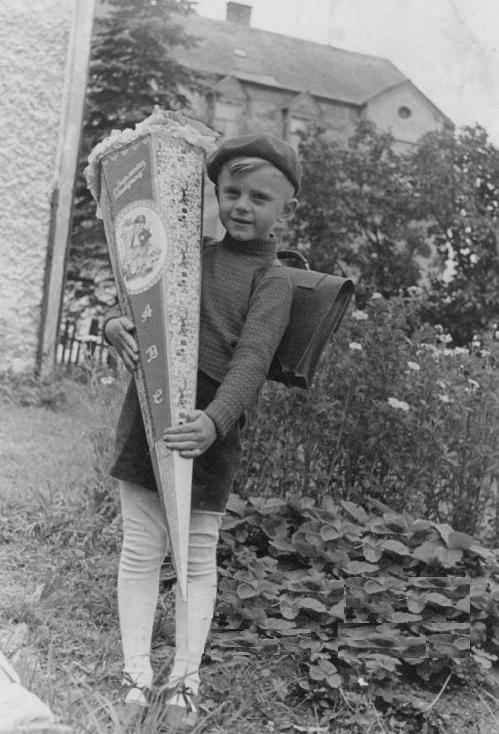
German Schoolwear: Hosiery Color

Figure 1.-- Dad had a little trouble keeping the camera level, but this German boy seems pleased with himself and his school treat cone. He wears a beret, wewater, short bpants, white long stockings and strap shoes. The white long stockings were not very common for boys, especially for schoolwear. The snapshot is undated, but looks like the late-1930s. A reader writes, "If you look carefully you will notice that the boy is wearing long underwear under the white stockings. The ankle cuffs are visible through the stockings. It probably was a bit chilly when the school started. He is also wearing a knit sweater which may have been hand knitted."
|
|
Hosiery color varied over time. We know little about the early-19th century. We know much more once photography becomes available. Unfortunltely the black and white photography of the 19th and early-20th century makes it difficult to determine colors other than light and dark. We see white stockings in the mid-19th centuries. Then we see some striped long stockings, although our 19th century archive is limited. Finally we see dark stockings becoming more impotant. This continued into the early-20th century. After World War I hosiery became more varied. We se grey and tan (flesh tones appearing). And we see many children wearing knee socks. White became popular for girls. We see boys dressing up with white knee socks, but not wearing them to school. White long stockings were less common, especially for school. Girls did, howevr wear white socks and stockings to school. We no longer see black long stockings at school as commonly as they once wre. They wre down seen as more of a dress-up color for formal occassions. We do see boys wearing older, somewaht faded black stockings to school. After World War II, patterned knee socks became popular for a while. And we begin to get some color images. We mostly see grey and brown long stockings. But by the 1960s we mostly see flat colors, mostly grey and tan for the boys. By this time, however, boys were increasingly wearing long pants and we can no longer make out much about their hosiery. We do continue to see girl's hosiery. In the late-1950s tights appear. we begin to see colorful tights as well as a much greater variety of colored knee socks.
HBC-SU

Related Chronolgy Pages in the Boys' Historical Web Site
[Main Chronology Page]
[The 1880s]
[The 1930s]
[The 1940s]
[The 1950s]
[The 1960s]
[The 1970s]
[The 1980s]
Related Style Pages in the Boys' Historical Web Site
[Main school uniform page]
[Main country page]
[Long pants suits]
[Short pants suits]
[Socks]
[Eton suits]
[Jacket and trousers]
[Blazer]
[School sandals]
[Strap shoes]
Navigate the Boys' Historical Clothing School Uniform Pages
[Return to the Main German school hosiery page]
[Return to the Main German schoolwear specific garment page]
[Return to the Main German schoolwear garment page]
[Return to the Main German headwear page]
[Return to the Main national school cap page ]
[Australia]
[England]
[France]
[Italy]
[Japan]
[New Zealand]
[Scotland]
[United States]
Navigate the Boys' Historical Clothing Web Page
[Introduction]
[Activities]
[Biographies]
[Chronology]
[Clothing styles]
[Countries]
[Bibliographies]
[Contributions]
[FAQs]
[Glossaries]
[Images]
[Links]
[Registration]
[Tools]
[Boys' Clothing Home]
Created: 8:18 PM 3/30/2015
Last updated: 1:18 PM 4/1/2015




